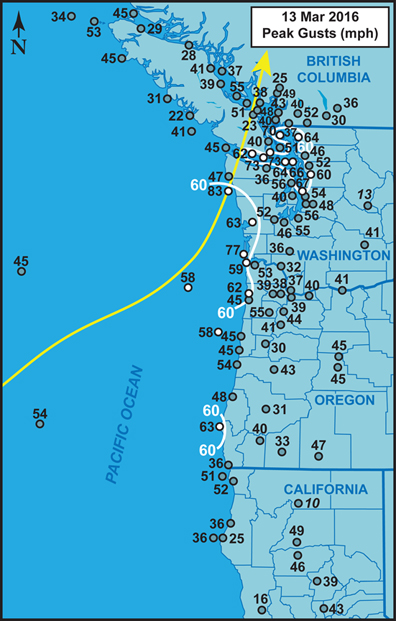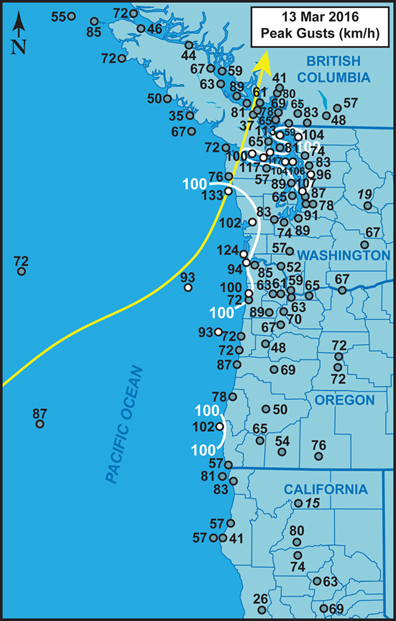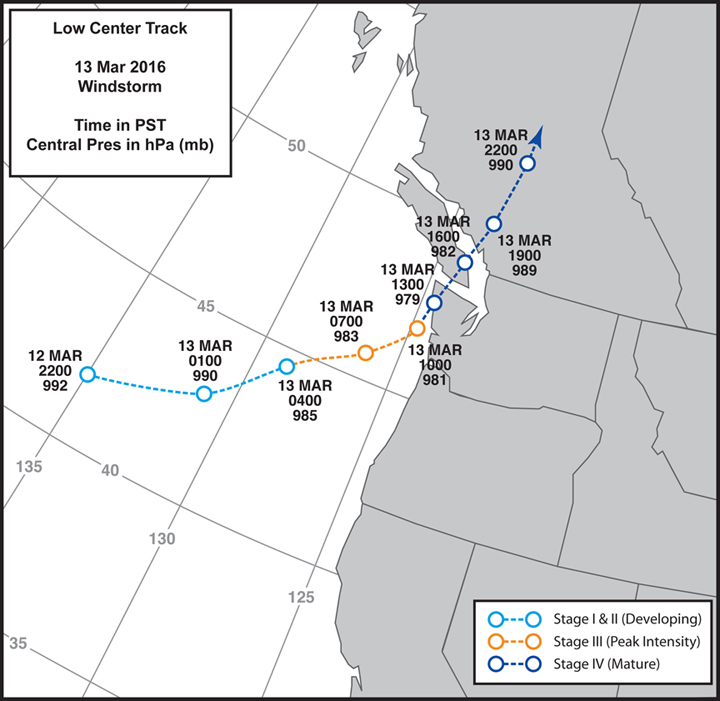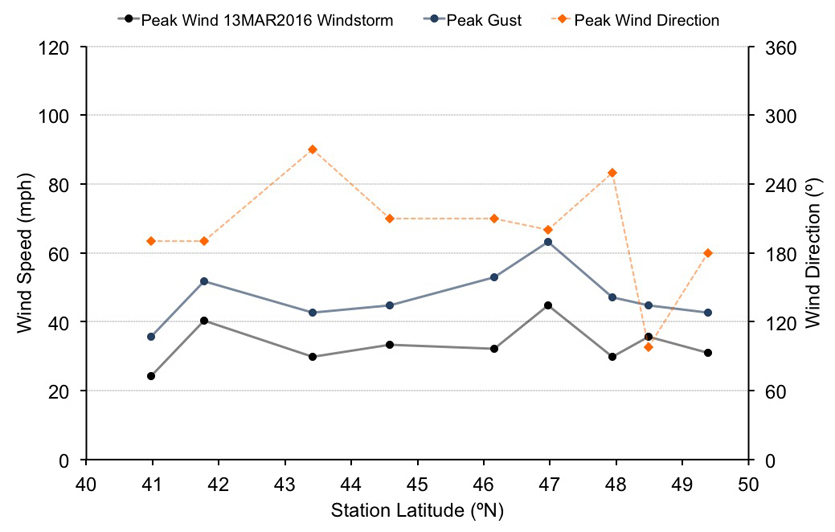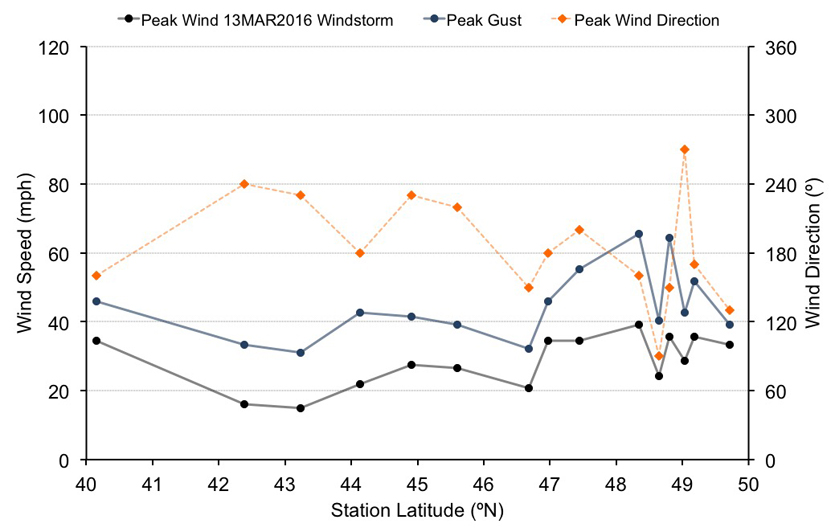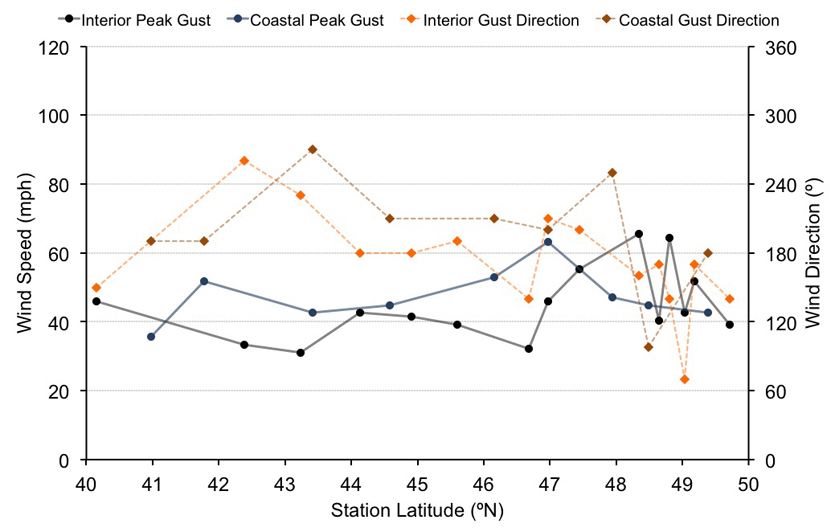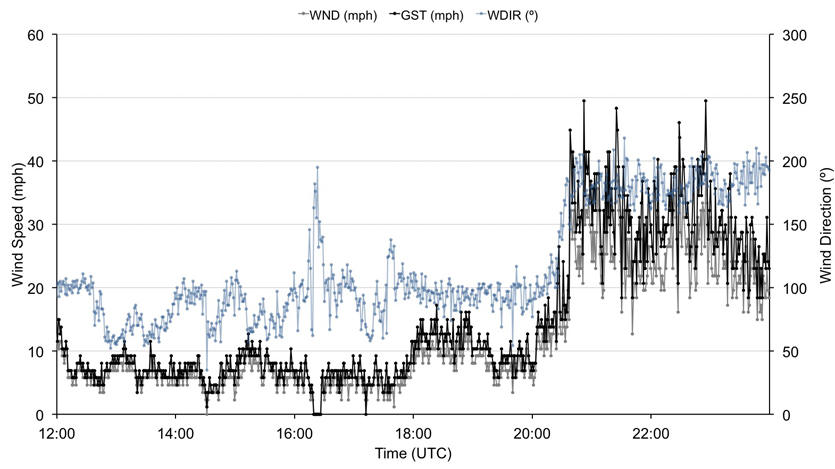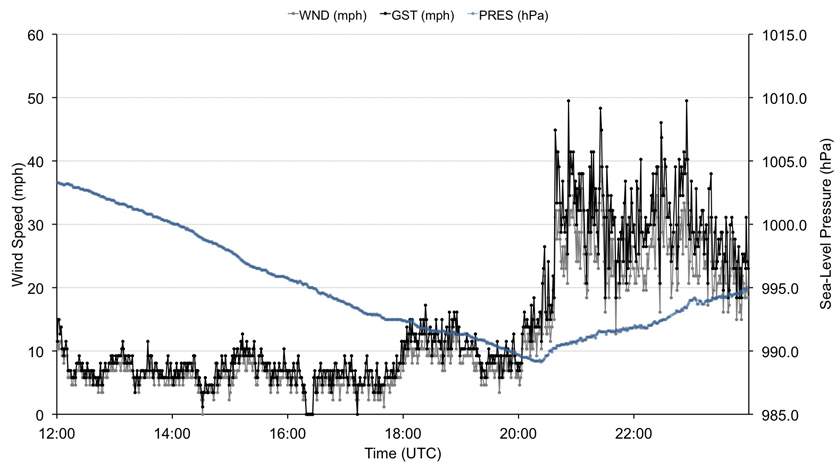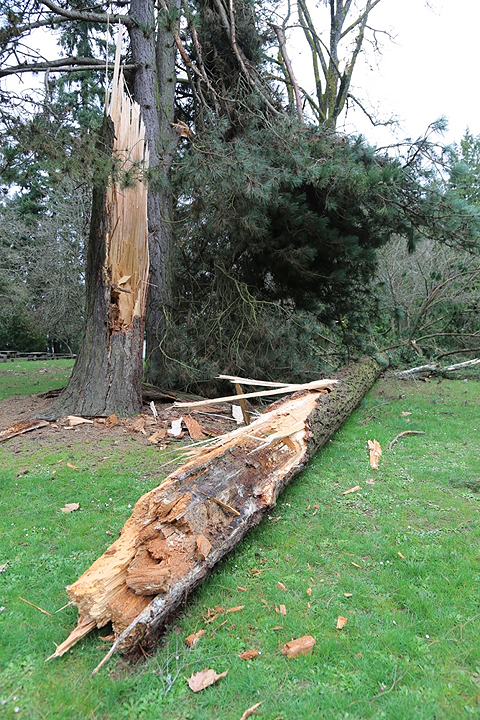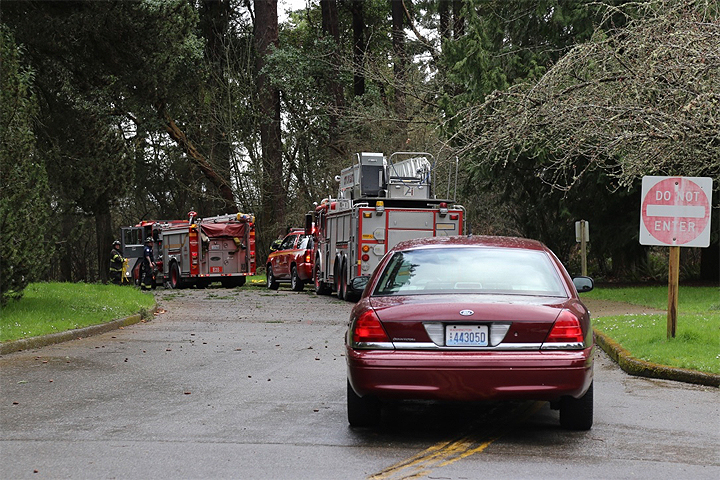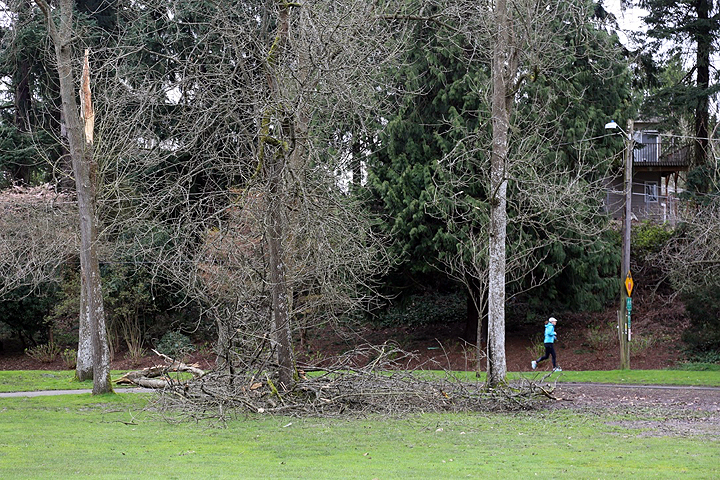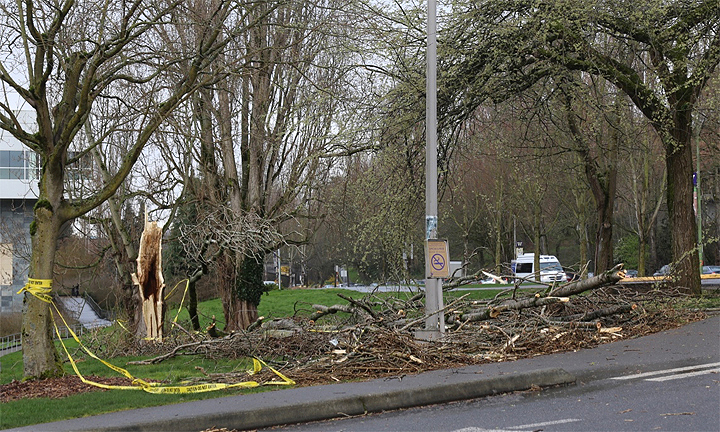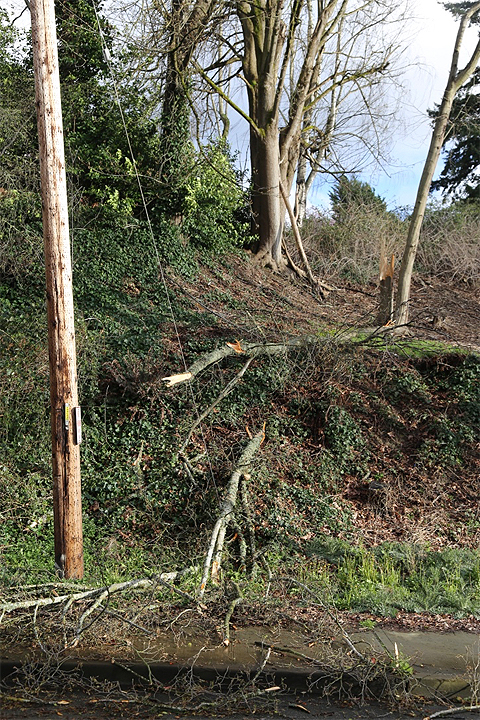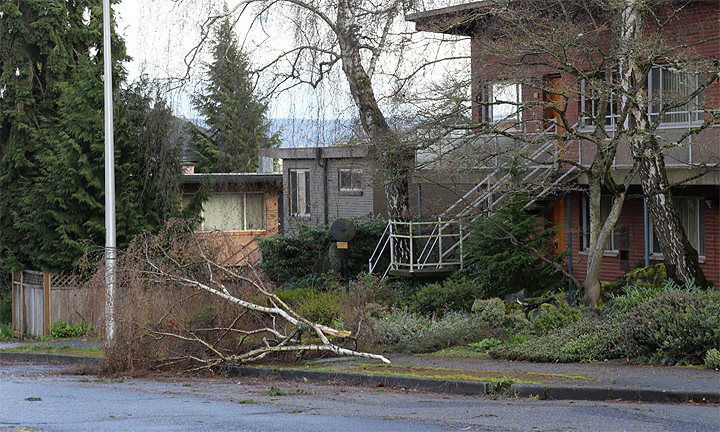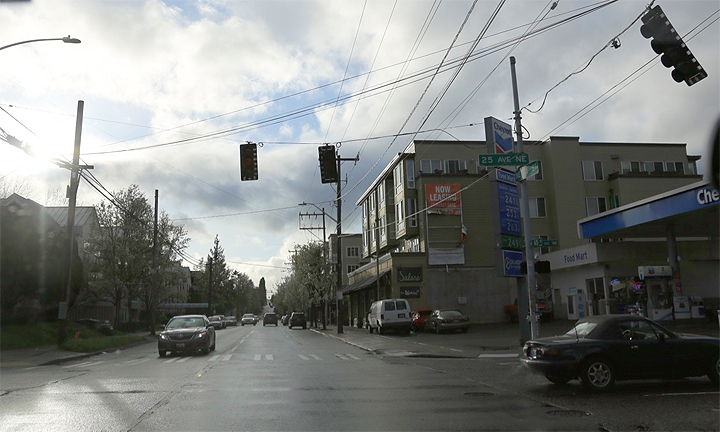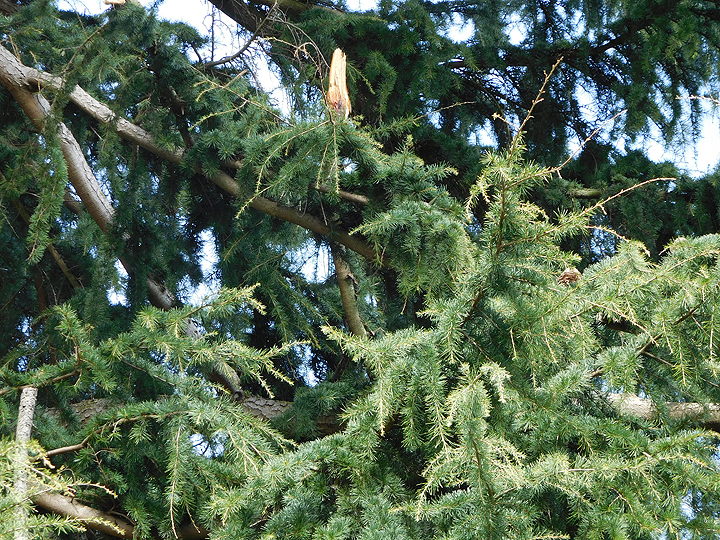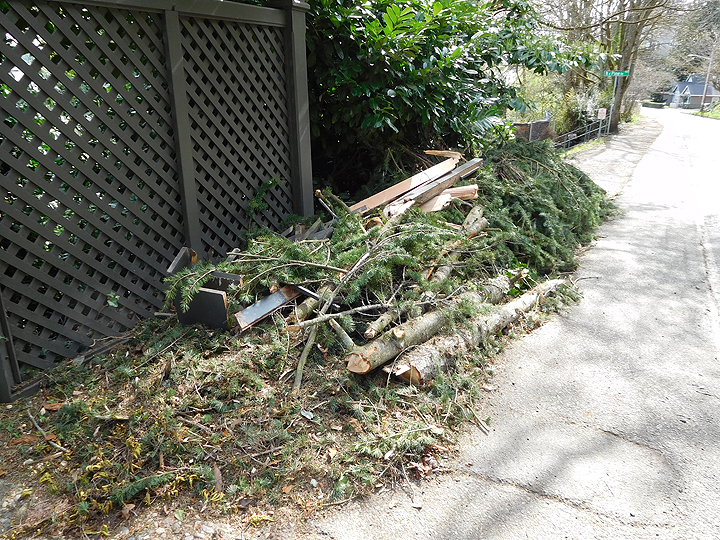Figure 1.1 above Peak gusts (mph and km/h) for the March 13, 2016 windstorm. Wind speeds are largely from long-term surface airways weather observation sites, data buoys, lighthouses and C-MAN stations, with limited data from other networks (e.g. RAWS). Stations with long histories are preferred because of the research focus on intercomparison of historic storms. Numbers preceded by a tilde (~) represent the highest gust report in a dataset that has been interrupted at the height of the storm--usually data loss is from power outages. Values in italics are gusts estimated from peak wind, usually 2-minute or 5-minute, using a 1.3 gust factor. Stations with high-wind criteria gusts (58 mph or 93 km/h) are denoted with white-filled circles. Isotachs depicting ≥60 mph (~100 km/h) gusts are included to highlight the regions that had concentrations of the indicated magnitudes. The track of the extratropical cyclone center is shown (yellow arrow). Click on the map to see a larger version. Here is a map listing the station names. |
Just three days after an intense low tracked over northern Vancouve Island, lashing parts of Cascadia with high winds on March 10, 2016, another strong extratropical cyclone developed in the base of a broad and deep Gulf of Alaska (GAK) low overnight on March 12-13, 2016. The new cyclone steadily intensified as it rotated around the outskirts of the GAK low, starting out on a easterly track and then curving to the northeast off of the Oregon coast and eventually nearly due north as the storm swept onto the shores of the Olympic Peninsula of Washington (Figure 1.1). This track is a classic one for Seattle windstorms, though not to be confused with the "classic path" category used on the Storm King to refer to storms with paths similar to the 1962 Columbus Day Storm. Given the timing--arriving on the first day of "spring forward" or daylight savings time, the system could be referred to as the "Daylight Savings Storm". The March 13, 2016 windstorm produced a rather focused band of high winds in areas that ended up on the immediate southeast side of the low-pressure center (Figure 1.1). California by and large did not receive particularly strong winds during this storm, likely due to the far offshore track. Gusts on the Redwood coast were in the rage of 35-50 mph (55-80 km/h), with similar speeds in the Sacramento Valley. Oregon received a glancing blow, with the coast receiving gusts generally 45-60 mph (70-95 km/h), and the interior 30-45 mph (50-70 km/h). The southern and central Washington coast, being brushed by the storm's strong bent-back front, received the brunt with gusts in the range of 60-80 mph (95-130 km/h). For the interior, the most intense winds of this storm just skirted north of the Puget Lowlands where wind gusts were generally 45-55 mph (70-85 km/h). The North Inland Waters region and parts of the Strait of Juan de Fuca received the brunt of the storm, with gusts of 60-75 mph (95-120 km/h). These gusts were from the SE in locations east of the Strait as the low approached and passed the region, and from the W in the Strait as the low moved inland to the north-northeast. The southern sections of Victoria, British Columbia, received these winds. The Saanich Peninsula was sheltered. Further north, peak winds were not as fast, even despite a storm track that is typically supportive of strong winds over the Lower Mainland. It almost seems like the high winds stopped at the Canadian border, with gusts in the greater Vancouver Metro area generally falling in the 40-50 mph (65-80 km/h) range. Vancouver Island's typically windy Pacific coast received relatively low gusts, as did much of the Georgia Strait mainly due to the low passing to the south and east of these regions. Given that the March 13, 2016 windstorm developed in the base of a deep Gulf of Alaska low, and followed in the wake of a predecessor storm that moved through the region the day before, barometric pressure was already quite low over the region before the arrival of the March 13th storm. For instance, ahead of the windstorm, the highest the pressure reached at Sea-Tac Airport was 1008.5 hPa (29.78" Hg) at 2153 PST on March 12th. This would fall to a rather low 990.7 hPa (29.26" Hg) at 1253 PST (1353 PDT) on March 13th as the low passed to the west, marking a total drop of 17.8 hPa (0.52" Hg). This is strong but not extreme: Many of the major high-wind generating extratropical cyclones have produced pressure drops in the range of 25-30 hPa (0.75-1.00" Hg). Thus, despite a 979 hPa (28.91" Hg) central pressure at landfall on March 13, 2016, the storm produced an outcome more reminiscent of a storm with a 985-990 hPa (~988 hPa or 29.18" Hg) central pressure. This includes the compact nature of the region of most intense gradient, and the relatively narrow zone where winds approached and exceeded high wind criteria. Had this low deepened another 10 hPa before landfall, gusts of 60-65 mph (95-105 km/h) would likely have been more common throughout the Puget Lowlands and perhaps a bit further south. Due to the compact nature of the storm, and the narrow region affected by high-wind criteria gusts, the track position mattered greatly in terms of wind outcomes. Had the storm landed just a little further south and/or tracked a little more northeast instead of almost due north after reaching the Washington coast, thereby bringing the tip of the bent-back front further south and east, stronger winds may have affected more of the Puget Lowlands. The low center appears to have gone very near Destruction Island, resulting in a pressure minimum of 979.5 hPa (28.92" Hg) at 1300 PDT. Strong SE winds immediately preceded this lowest pressure, with a gust to 76 mph at 1247 PDT. The southeasterlies were followed by even more intense W winds as the low tracked inland and the bent-back front swept over the island: gusts reached 83 mph at 1505 PDT. A pressure surge of 7.5 hPa in the hour ending 1600 PDT accompanied those westerly winds, intense but not close to a record value--about on par for a strong extratropical cyclone. The peak gust distribution of this windstorm is quite reminiscent of events with similar tracks on December 21, 1982 and November 24, 1983. The former storm occurred during the strong 1982-1983 El Nino, while the latter happened just afterwards. Synoptic patterns with persistent southwest flow occurred repeatedly around the time of the 1982-1983 El Nino. This happened again during the great two-season El Nino of 2014-2016, and the March 13, 2016 windstorm developed in one of several persistent south to southwesterly storm trains during the storm season of 2015-2016. Indeed the March 13, 2016 windstorm was one of several that occurred during the 2014-2016 El Nino, including storms on December 11, 2014, August 29, 2015, December 21, 2015 and March 10, 2016. Many of these windstorms had strongly meridional paths, reflecting the tendency for south to southwest flow. |
